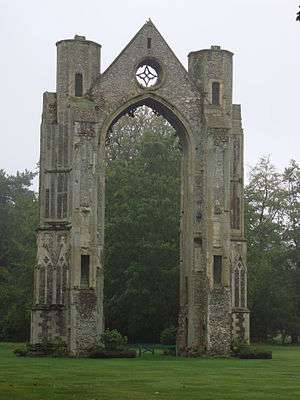Walsingham Priory

_-_Copy.jpg)
Walsingham Priory was a monastic house in Walsingham, Norfolk, England. The priory is perhaps best known for housing a Marian shrine with a supposed replica of the house of the Holy Family in Nazareth. Walsingham Abbey Grounds and the Shirehall Museum are opened to the public.
History
Walsingham Priory stood a few miles from the sea in the northern part of Norfolk, England. Founded in the time of Edward the Confessor, the chapel of Our Lady of Walsingham was confirmed to the Augustinian Canons a century later and enclosed within the priory.[2]
From the first this shrine of Our Lady was a famous place of pilgrimage. Hither came the faithful from all parts of England and from the continent until the destruction of the priory by Henry VIII in 1538. To this day the main road of the pilgrims through Newmarket, Brandon, and Fakenham is still called the Palmers' Way. Many were the gifts of lands, rents, and churches to the canons of Walsingham, and many the miracles wrought at Our Lady's shrine.[2]
Henry III came on a pilgrimage to Walsingham in 1241, Edward I in 1280 and 1296, Edward II in 1315, Henry VI in 1455, Henry VII in 1487, and Henry VIII in 1513.[2]
Erasmus in fulfilment of a vow made a pilgrimage from Cambridge in 1511, and left as his offering a set of Greek verses expressive of his piety. Thirteen years later he wrote his colloquy on pilgrimages, wherein the wealth and magnificence of Walsingham are set forth, and some of the reputed miracles rationalized.[2]
In 1537, while the last prior, Richard Vowell, was paying obsequious respect to Cromwell, the sub-prior Nicholas Milcham was charged with conspiring to rebel against the suppression of the lesser monasteries, and on flimsy evidence was convicted of high treason and hanged outside the priory walls.[2]
In July, 1538, Prior Vowell assented to the destruction of Walsingham Priory and assisted the king's commissioners in the removal of the figure of Our Lady, of many of the gold and silver ornaments and in the general spoliation of the shrine. For his ready compliance the prior received a large pension of 100 pounds a year, while fifteen of the canons received pensions varying from 4 pounds to 6 pounds.
The shrine dismantled, and the priory destroyed, its site was sold by order of Henry VIII to one Thomas Sidney for 90 pounds, and a private mansion was subsequently erected on the spot.[2]
The Elizabethan ballad, "A Lament for Walsingham," expresses something of what the faithful felt at the loss of their glorious shrine of Our Lady of Walsingham.[2] On the other hand, the ballad literature suggests that some pilgrims sought non-religious encounters: Ophelia in Hamlet quotes from lyrics about Walsingham in which a woman asks about her pilgrim lover.[3]
References
- ↑ Chambers, Robert (1832). The Book of Days: A Miscellany of Popular Antiquities in Connection with the Calendar, Including Anecdote, Biography, & History, Curiosities of Literature and Oddities of Human Life and Character, Volume 2. London: W. & R. Chambers Limited. Retrieved 7 January 2016.
- 1 2 3 4 5 6 7 Herbermann 1913.
- ↑ "Ophelia's Version of the Walsingham Song". F. W. Sternfeld Music & Letters, Vol. 45, No. 2 (Apr., 1964), pp. 108-113 Published by: Oxford University Press. Accessed via JSTOR: article Stable URL: http://www.jstor.org/stable/732068 (subscription required)
- Attribution
![]() This article incorporates text from a publication now in the public domain: Herbermann, Charles, ed. (1913). "Walsingham Priory". Catholic Encyclopedia. New York: Robert Appleton.
This article incorporates text from a publication now in the public domain: Herbermann, Charles, ed. (1913). "Walsingham Priory". Catholic Encyclopedia. New York: Robert Appleton.
External links
- Official website
- "Houses of Austin canons: The priory of Walsingham". A History of the County of Norfolk. British History Online. 2. University of London & History of Parliament Trust. 1906. pp. 394–401.
- "WALSINGHAM PRIORY". Pastscape.
Coordinates: 52°53′37″N 0°52′33″E / 52.8936°N 0.8757°E